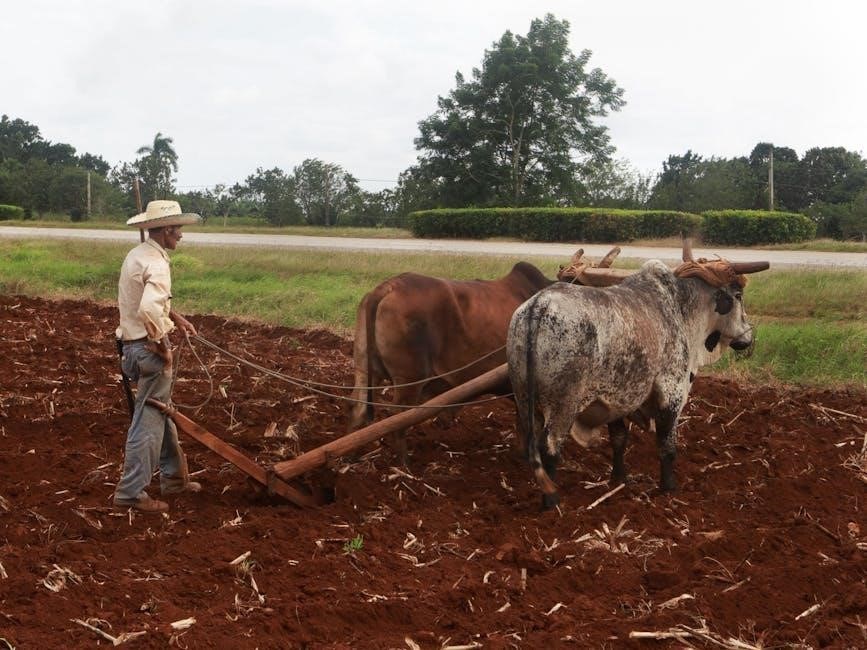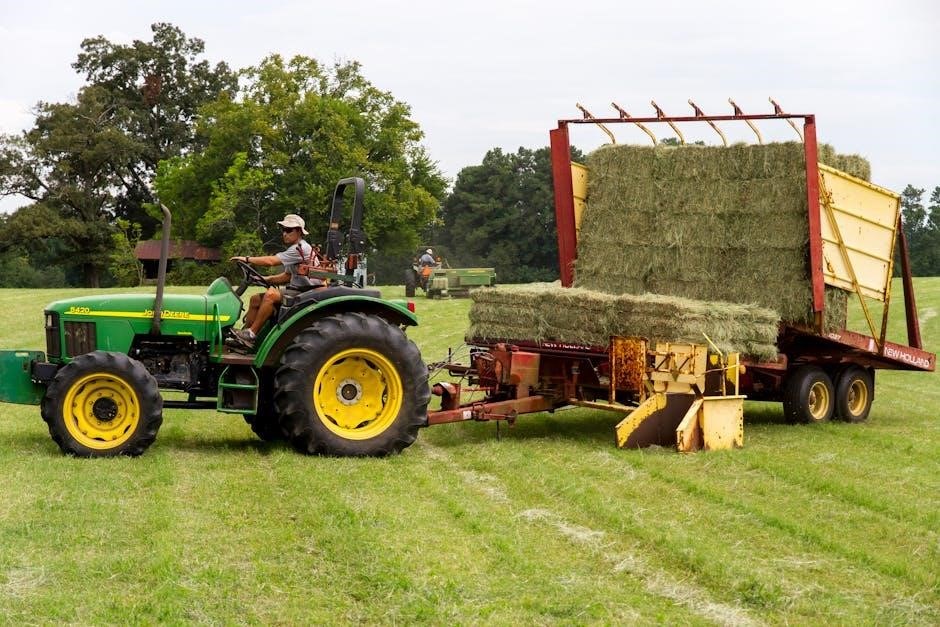Plow manuals are essential guides for operating, maintaining, and troubleshooting plows. They cover setup, safety, and best practices, ensuring efficient and safe plowing for agricultural and snow removal tasks.
1.1 Importance of Plow Manuals
Plow manuals are crucial for safe and effective plowing, providing detailed instructions and safety guidelines. They ensure proper setup, operation, and maintenance, preventing equipment damage and accidents. Manuals also outline legal requirements for snow plowing and offer troubleshooting tips. By following these guides, users can optimize plow performance, reduce environmental impact, and comply with regulations. Whether for agricultural or snow removal, plow manuals are indispensable for achieving professional results and protecting investments in plowing equipment.
1.2 History and Evolution of Plow Manuals
Plow manuals have evolved significantly over time, from basic agricultural guides to comprehensive digital resources. Early manuals focused on simple plowing techniques, while modern versions include detailed instructions for complex machinery. The rise of snow plowing expanded their scope, covering mechanical and hydraulic systems. Today, manuals are accessible online, offering troubleshooting, maintenance tips, and legal requirements. This evolution reflects advancements in technology and user needs, ensuring plow manuals remain vital for effective and safe plowing across various applications.
Types of Plows
Plows come in various types, including agricultural plows like moldboard, disc, and chisel plows, and snow plows such as ATV-mounted, truck-mounted, and hand-push models, each designed for specific tasks.
2.1 Agricultural Plows (Moldboard, Disc, Chisel)
Agricultural plows are vital for soil preparation. Moldboard plows effectively turn over and aerate soil, ideal for deep tilling. Disc plows cut and mix soil with less disturbance, suitable for hard or rocky ground. Chisel plows loosen soil without flipping it, perfect for maintaining topsoil integrity. Each type targets specific soil conditions and farming needs, ensuring optimal crop growth and land management. Proper selection based on soil type and farm requirements is essential for maximizing agricultural productivity.
2.2 Snow Plows (ATV, Truck-Mounted, Hand-Push)
Snow plows are essential for clearing snow efficiently. ATV-mounted plows are ideal for small areas like driveways, offering maneuverability and ease of use. Truck-mounted plows are robust, designed for large-scale commercial snow removal. Hand-push plows are lightweight, perfect for residential use. Each type has specific features, such as blade materials and hydraulic controls, ensuring effective snow clearance. Proper setup and maintenance, including blade lubrication and regular inspections, are crucial for optimal performance. Understanding the right plow for your vehicle and needs ensures safe and efficient snow management.
Choosing the Right Plow
Selecting the right plow involves considering soil type, climate, and vehicle compatibility. Popular brands like Western, Fisher, and SnowDogg offer models suited for various needs and budgets.
3.1 Factors to Consider (Soil Type, Climate, Vehicle Compatibility)
When selecting a plow, consider soil type, climate, and vehicle compatibility. Soil type determines plow design; moldboard plows suit soft soils, while disc plows handle rocky terrain. Climate influences durability and features; heavy snow requires robust plows with hydraulic systems. Vehicle compatibility ensures proper fit and performance; check weight capacity, hitch type, and power output. Matching these factors ensures efficient and safe plowing, optimizing your equipment for specific conditions and tasks.
3.2 Popular Brands and Models (Western, Fisher, SnowDogg)
Western, Fisher, and SnowDogg are leading brands in plowing equipment, known for durability and performance. Western offers the MVP Plus series, popular for its versatility and advanced features. Fisher plows, like the HDX series, are favored for heavy-duty applications. SnowDogg, known for affordability, provides models like the MD75, ideal for medium-duty use. These brands cater to various needs, ensuring compatibility with different vehicles and conditions, making them top choices for both professionals and homeowners.

Safety Precautions

Always wear protective gear, inspect equipment, and ensure proper visibility. Be aware of surroundings and obstacles. Adhere to speed limits and avoid plowing near pedestrians or vehicles.

4.1 General Safety Guidelines
Always wear protective gear, including gloves, safety glasses, and a helmet. Conduct a pre-operation inspection of the plow and vehicle. Ensure proper visibility by using lights and reflectors. Avoid plowing near pedestrians, pets, or vehicles. Maintain a safe speed and keep a distance from obstacles. Be aware of uneven terrain and hidden hazards. Never plow in reverse without clear visibility. Keep children and bystanders away from the plowing area. Follow manufacturer instructions for attachments and operation. Ensure proper hydration and take breaks to avoid fatigue. Familiarize yourself with emergency shutdown procedures. Adhere to local regulations and safety standards for plowing activities.
4.2 Legal Requirements for Snow Plowing
Ensure you have proper permits and insurance for snow plowing, especially for commercial use. Check local ordinances for licensing requirements. Commercial plowing may require a specific vehicle class, such as an F350. Verify that your plow meets municipal regulations. Familiarize yourself with environmental regulations regarding salt and chemical use. Ensure proper lighting and visibility on your plow. Register your equipment with local authorities. Understand liability laws for damage caused during plowing. Keep records of permits and insurance for legal compliance. Adhere to contractual obligations if operating commercially.
Operating a Plow
Operating a plow involves proper preparation, setup, and techniques. Adjust angles and speed for effective coverage, ensuring safety and efficiency in plowing operations.
5.1 Preparation and Setup
Proper preparation and setup are crucial for effective plowing. Start by attaching the plow to your vehicle correctly, ensuring all hydraulic and electrical connections are secure. Check the blade alignment and angle to match your plowing needs. Test the plow’s lift and angle functions before use. Always consult the manual for specific setup instructions, as improper installation can lead to poor performance or damage. Ensure the vehicle is equipped with the necessary weight distribution and tires for stability. Finally, perform a pre-operation test run to verify everything functions smoothly.
5.2 Plowing Techniques (Angle, Speed, Coverage)
Mastering plowing techniques involves adjusting the angle, speed, and coverage for optimal results. Start with a 45-degree angle for light snow and reduce it for heavier loads. Maintain a steady speed, slower for deep snow and faster for lighter layers. Overlap passes slightly to ensure full coverage. Work in sections, turning at the end of each pass to maintain even distribution. Reverse direction occasionally to prevent ridges. For large areas, divide the space into manageable zones. Use straight, consistent passes for uniform clearing. Proper technique ensures efficiency and avoids damage to surfaces and equipment.

Maintenance and Repair
Regular maintenance ensures plow longevity. Check and lubricate moving parts, inspect blades for wear, and address issues promptly to prevent costly repairs and downtime.
6.1 Regular Maintenance (Lubrication, Blade Care)
Regular maintenance is crucial for optimal plow performance. Lubricate all moving parts, such as hinges and cylinders, to prevent rust and wear. Inspect and clean blades frequently, removing dirt and debris. Sharpen or replace worn blades to maintain efficiency. Apply protective coatings to prevent corrosion. Check hydraulic systems for leaks and ensure proper fluid levels. Schedule routine inspections to address issues early, extending the lifespan of your plow and ensuring reliable operation throughout the season.
6.2 Troubleshooting Common Issues
Identify and address common plow issues promptly to avoid downtime. Blade malfunctions, such as uneven cutting or damage, often result from obstructions or improper alignment. Inspect hydraulic lines for leaks or blockages and ensure fluid levels are adequate. Lift mechanism issues may stem from worn-out pins or faulty sensors. Refer to your plow manual for specific diagnostic steps. Regularly check for loose bolts and tighten as needed. For complex problems, consult the manufacturer or a professional technician. Keep a repair kit on hand for quick fixes, ensuring your plow operates efficiently throughout the season.
Seasonal Preparation
Seasonal preparation involves pre-season checks and post-season storage to ensure your plow operates efficiently and lasts longer. Proper maintenance is key to reliability and performance.
7.1 Pre-Season Checks

Pre-season checks are crucial for ensuring your plow is ready for winter. Inspect the blade for wear, check hydraulic fluids, and test lift mechanisms. Lubricate moving parts and replace worn components. Verify electrical connections and ensure all safety features function properly. Review your plow manual for specific instructions tailored to your model. A thorough inspection helps prevent mid-season breakdowns and ensures optimal performance. Addressing issues early saves time and money, keeping your plow in top condition for efficient snow removal.
7.2 Post-Season Storage
Proper post-season storage is vital for maintaining your plow’s condition. Clean the blade and frame thoroughly, removing dirt and debris. Apply rust-inhibiting coatings to metal parts and lubricate moving components. Store the plow in a dry, protected area to prevent corrosion. Disconnect and store hydraulic hoses to avoid damage. Inspect for worn or damaged parts and address them before storing. Consult your plow manual for specific storage recommendations. Proper storage ensures your plow remains functional and ready for the next season, saving time and money on repairs.

Environmental Considerations
Adopt eco-friendly plowing practices to minimize environmental impact. Reduce chemical use by using salt-free or biodegradable alternatives. Optimize fuel efficiency and avoid excessive plowing to protect ecosystems.
8.1 Eco-Friendly Plowing Practices
Eco-friendly plowing practices focus on minimizing environmental impact. Use biodegradable or salt-free alternatives to reduce soil and water contamination. Pre-wetting salts with beet juice enhances efficacy at lower temperatures, reducing overall usage. Opt for plows with adjustable blades to minimize waste and energy consumption. Regular maintenance ensures equipment efficiency, lowering fuel consumption and emissions. Consider using electric or hybrid plows for smaller areas to reduce carbon footprints. Proper storage and disposal of plowing materials prevent environmental harm. Adopting these practices helps protect ecosystems while maintaining effective snow and soil management;
8.2 Reducing Chemical Use in Snow Plowing
To minimize environmental impact, reduce chemical use by applying salts sparingly and using pre-wetted mixes with natural additives like beet juice. This enhances effectiveness at lower temperatures, reducing overall salt consumption. Consider alternatives like sand for traction on low-temperature surfaces. Calibrate spreaders to ensure precise application, avoiding overuse. Additionally, adopt smart plowing technologies that monitor and adjust chemical dispersion based on real-time conditions. These practices not only protect ecosystems but also lower operational costs and maintain plowing efficiency.

Future Trends in Plowing Technology
Future plowing technology will focus on autonomous systems and advanced hydraulic controls, enhancing efficiency and reducing manual labor, while integrating eco-friendly solutions for sustainable practices.
9.1 Autonomous Plows
Autonomous plows represent the next leap in plowing technology, utilizing GPS, sensors, and AI to navigate and clear surfaces without human intervention. These systems enhance precision, reduce labor costs, and operate round the clock. They are particularly advantageous for large-scale agricultural and snow removal operations, ensuring consistent and efficient results. Autonomous plows can adapt to varying terrains and conditions, making them versatile for diverse applications. As technology advances, these plows are expected to become more prevalent, revolutionizing the industry.

9.2 Hydraulic and Wireless Control Advancements
Hydraulic and wireless control advancements have significantly enhanced plow operation efficiency. Modern hydraulic systems offer precise flow control, reducing leakage and improving response times. Wireless controllers eliminate the need for complex wiring, enabling seamless operation from a distance. These systems are compatible with major brands, allowing easy integration. Operators can adjust settings on the go, reducing wear on equipment and improving safety. Such innovations minimize mechanical failures and downtime, ensuring smoother plowing experiences. These advancements are reshaping the industry, offering greater convenience and reliability for both agricultural and snow plowing applications.
Mastering plow operations ensures efficiency and safety. This guide provides essential tips, troubleshooting, and insights into future trends like autonomous plows, helping you stay ahead in plowing tasks.
10.1 Summary of Key Points
10.2 Final Tips for Effective Plowing

- Always ensure proper preparation of your plow and vehicle before starting.
- Regularly inspect and maintain the blade for optimal performance.
- Stay alert and hydrated, especially during long plowing sessions.
- Plow in consistent, overlapping passes to avoid missed spots.
- Adjust your speed according to conditions to maintain control.
- Conduct seasonal checks to prepare for the next plowing season.
- Adopt eco-friendly practices to minimize environmental impact.
By following these tips, you can ensure safe, efficient, and effective plowing operations.
